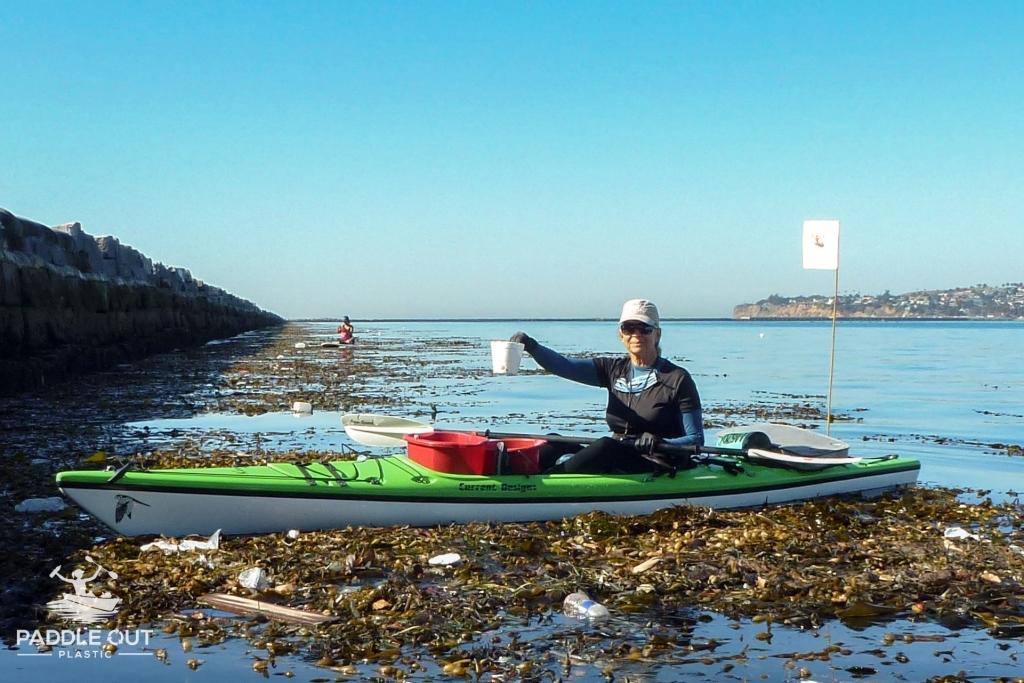April 23, 2021

Trash floats along the Cabrillo Beach breakwater by Paddle Out Plastic
With every launch of my kayak, I wonder, “Will this be the morning I don’t find any plastic litter?” But each time out I retrieve hundreds, and often thousands, of plastic products and unidentifiable pieces of plastic from LA area waters. It has gotten worse over time, so much so that I launched Paddle Out Plastic in June 2019 hoping to inspire other paddlers to pick up litter while out on the water; to hold governments accountable to their zero waste goals; and to post pictures and videos online on social media, because the visuals of what is drifting into our waterways and to the ocean are so striking, they call for action.

Paddle Out volunteer tows a pile of plastic litter fished out of LA Harbor.
We paddle weekly, some of us by kayak and some on paddleboards, finding all manner of food-related and other plastic in open water and kelp beds. Expanded polystyrene, aka styrofoam, is very common--cups, plates, clamshells, and fragments of all sizes. We have retrieved more than 25,000 pieces of styrofoam since we began counting in June 2019. Chip and candy wrappers are another ubiquitous item we remove from the water. Although plastic bags are fewer by number, their size and the ingestion hazard they present to marine life like sea turtles and whales make them a top troublemaker. All told, in 2020 alone we removed over 40,000 plastic pieces from Southern California waters. Lids, straws, bottles, cups, product wrappers, toys, packing material, balloons, gloves, masks, fishing gear—the list goes on and on. In 2021, we’re on pace to far exceed our 2020 numbers, having already removed 18,000 pieces in the first three months.

Eva Cicoria, Paddle Out volunteer, raises styrofoam cup fished out from the harbor.
The progress we are making to remove plastic from our waterways is not enough. We are paddling against a current of single-use plastic proliferation that must abate. We sort, count, and log our data under the National Oceanic and Atmospheric Administration’s list in the Marine Debris Tracker app and nudge policymakers locally and beyond to face the reality we witness every paddle. The California Ocean Litter Prevention Strategy engages governmental agencies and NGOs in tackling a broad set of goals, including reduction of common land-based litter items through mandates, incentives, and design changes; improved waste management and interception; research and education; and reduction in ocean-based marine debris.

The Break Free From Plastic Pollution Act, introduced by Congressman Lowenthal, Congresswoman Clark, and Senator Merkley, addresses producer responsibility, clean air and water, and environmental justice. One of the sections will require all retailers to charge a 10 cent tax on any carry-out bag, and a portion of it will be deposited in the Recycling and Litter Cleanup Trust Fund.
The sweep of these goals reflects the diverse and complex nature of the problem. There is not one source and not one cause. There won’t be a single solution. Yet, single-use plastic is the most common element in what we see and in what several of the Strategy’s goals address. Change is slow, though, and the plastic and petroleum industries are resistant and powerful. You can help!
- Reduce your use of plastic, especially single-use plastic;
- Join our campaign, ask your Representative and Senator to endorse the Break Free From Plastic Pollution Act to help quell the flow down the plastic pollution pipeline;
- Join us on a paddle out if you have a vessel. Look us up at Paddle Out Plastic on Facebook and Instagram!
Eva Cicoria (she/her) is a former Conservation Chair and Newsletter Editor of the Palos Verdes-South Bay Group of the Sierra Club.
